Risk Management and Derivatives Report: Analysis and Evaluation
VerifiedAdded on 2020/04/21
|11
|1355
|51
Report
AI Summary
This report provides an analysis of risk management and derivatives, focusing on key concepts such as the VIX (Volatility Index), implied volatility, and the implications of using LVR (Leverage Ratio). The report explores the relationship between the VIX and market risk, explaining its calculation and use by investors. It differentiates between VIX volatility and implied volatility, highlighting their relevance in assessing market conditions. The report also delves into the potential risks associated with margin calls and forced liquidation when using margin loans, emphasizing the role of LVR in generating returns but also the possibility of significant losses. The analysis includes calculations and evaluations of various scenarios, supported by references to relevant literature on risk management and investment strategies. The report aims to provide a comprehensive understanding of the complexities involved in managing financial risk using derivatives and leverage.
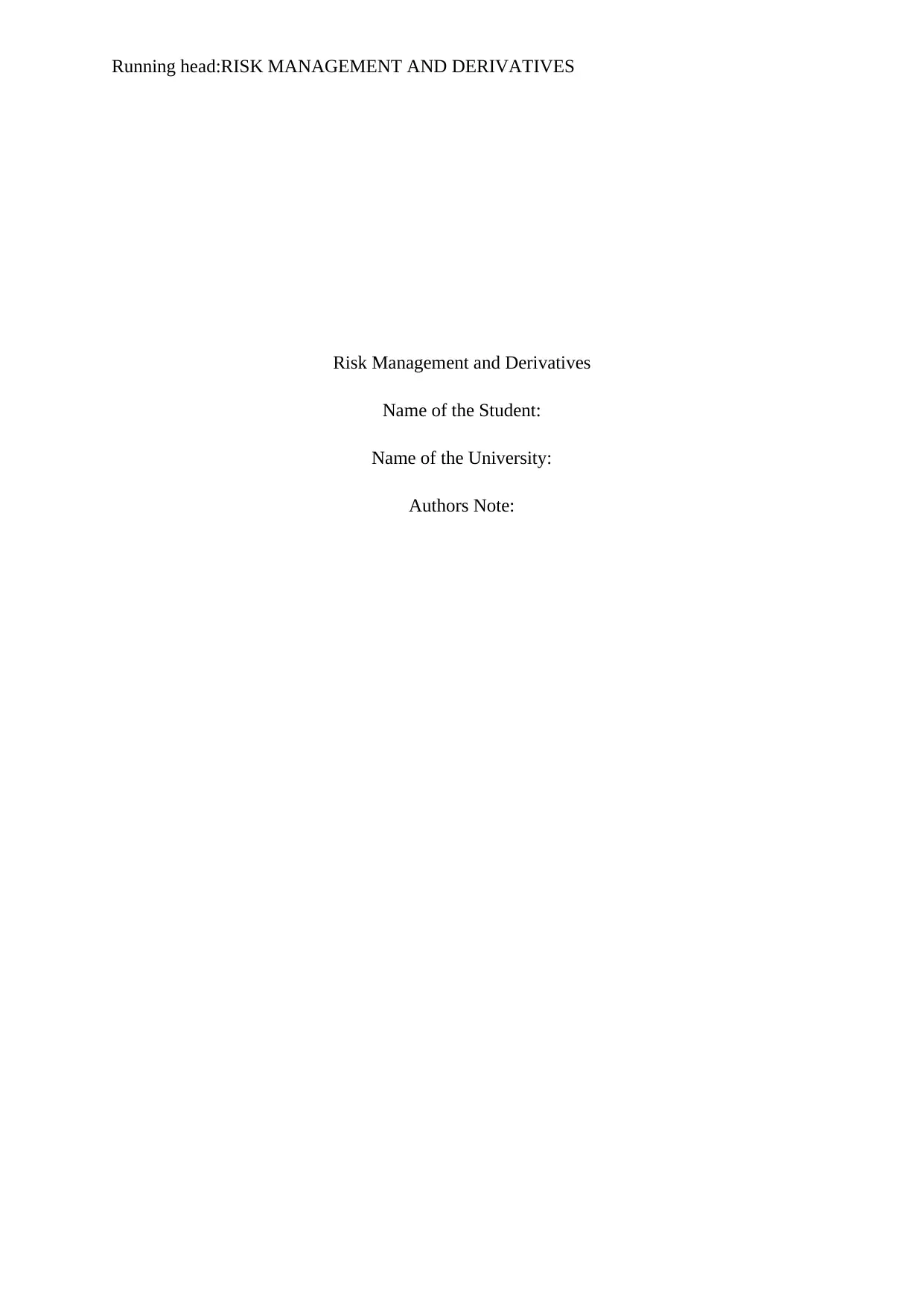
Running head:RISK MANAGEMENT AND DERIVATIVES
Risk Management and Derivatives
Name of the Student:
Name of the University:
Authors Note:
Risk Management and Derivatives
Name of the Student:
Name of the University:
Authors Note:
Paraphrase This Document
Need a fresh take? Get an instant paraphrase of this document with our AI Paraphraser

1
RISK MANAGEMENT AND DERIVATIVES
Table of Contents
Question 1a:...............................................................................................................................2
Question 1b:...............................................................................................................................2
Question 2a:...............................................................................................................................3
Question 2b:...............................................................................................................................3
Question 2c:...............................................................................................................................4
Question 3a:...............................................................................................................................5
Question 3b:...............................................................................................................................5
Question 3c:...............................................................................................................................6
Question 4a:...............................................................................................................................6
Question 4b:...............................................................................................................................7
Question 4c:...............................................................................................................................7
Question 5a:...............................................................................................................................7
Question 5b:...............................................................................................................................8
Question 5c:...............................................................................................................................8
Question 6:.................................................................................................................................8
Reference and Bibliography:....................................................................................................10
RISK MANAGEMENT AND DERIVATIVES
Table of Contents
Question 1a:...............................................................................................................................2
Question 1b:...............................................................................................................................2
Question 2a:...............................................................................................................................3
Question 2b:...............................................................................................................................3
Question 2c:...............................................................................................................................4
Question 3a:...............................................................................................................................5
Question 3b:...............................................................................................................................5
Question 3c:...............................................................................................................................6
Question 4a:...............................................................................................................................6
Question 4b:...............................................................................................................................7
Question 4c:...............................................................................................................................7
Question 5a:...............................................................................................................................7
Question 5b:...............................................................................................................................8
Question 5c:...............................................................................................................................8
Question 6:.................................................................................................................................8
Reference and Bibliography:....................................................................................................10
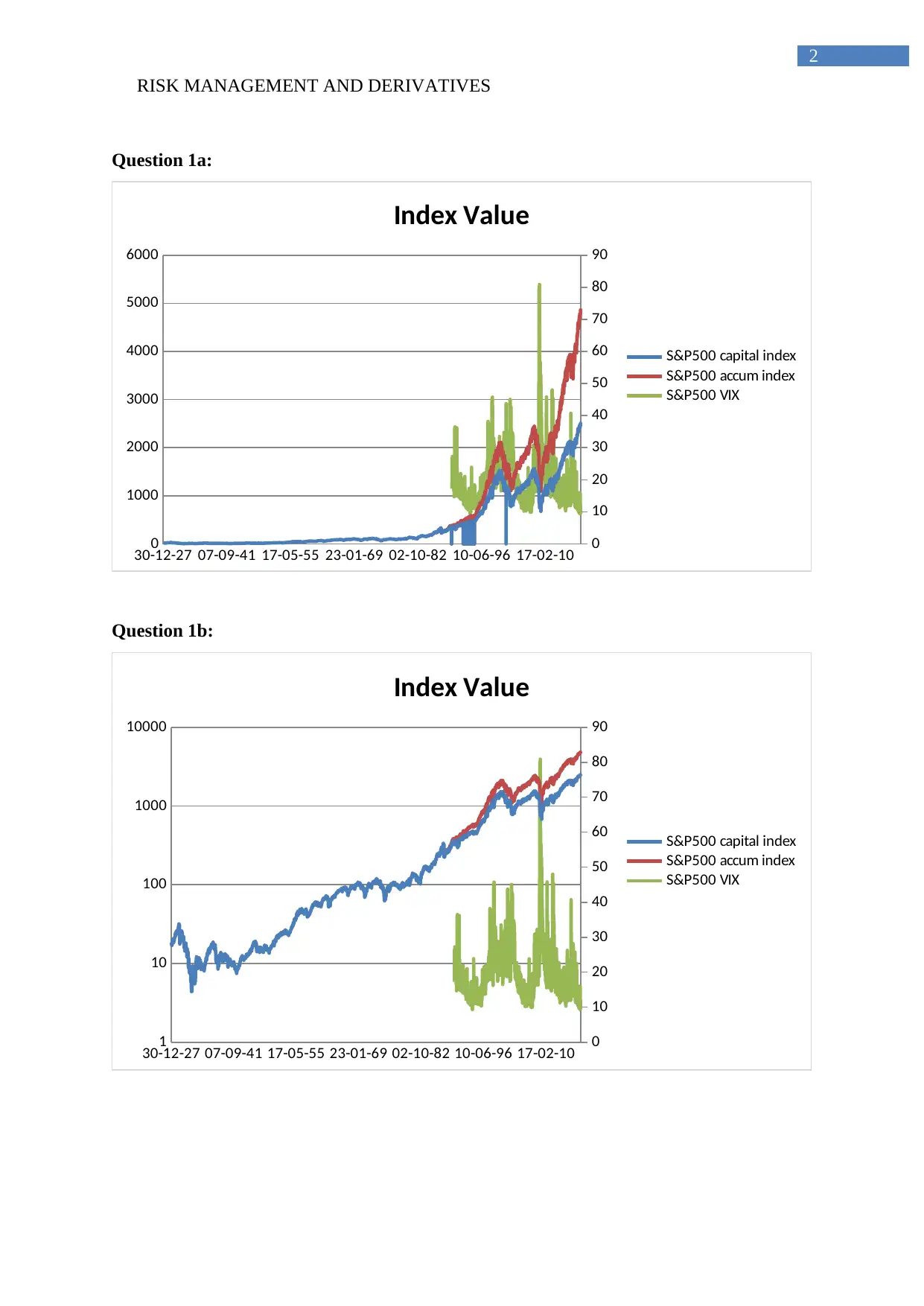
2
RISK MANAGEMENT AND DERIVATIVES
Question 1a:
30-12-27 07-09-41 17-05-55 23-01-69 02-10-82 10-06-96 17-02-10
0
1000
2000
3000
4000
5000
6000
0
10
20
30
40
50
60
70
80
90
Index Value
S&P500 capital index
S&P500 accum index
S&P500 VIX
Question 1b:
30-12-27 07-09-41 17-05-55 23-01-69 02-10-82 10-06-96 17-02-10
1
10
100
1000
10000
0
10
20
30
40
50
60
70
80
90
Index Value
S&P500 capital index
S&P500 accum index
S&P500 VIX
RISK MANAGEMENT AND DERIVATIVES
Question 1a:
30-12-27 07-09-41 17-05-55 23-01-69 02-10-82 10-06-96 17-02-10
0
1000
2000
3000
4000
5000
6000
0
10
20
30
40
50
60
70
80
90
Index Value
S&P500 capital index
S&P500 accum index
S&P500 VIX
Question 1b:
30-12-27 07-09-41 17-05-55 23-01-69 02-10-82 10-06-96 17-02-10
1
10
100
1000
10000
0
10
20
30
40
50
60
70
80
90
Index Value
S&P500 capital index
S&P500 accum index
S&P500 VIX
⊘ This is a preview!⊘
Do you want full access?
Subscribe today to unlock all pages.

Trusted by 1+ million students worldwide
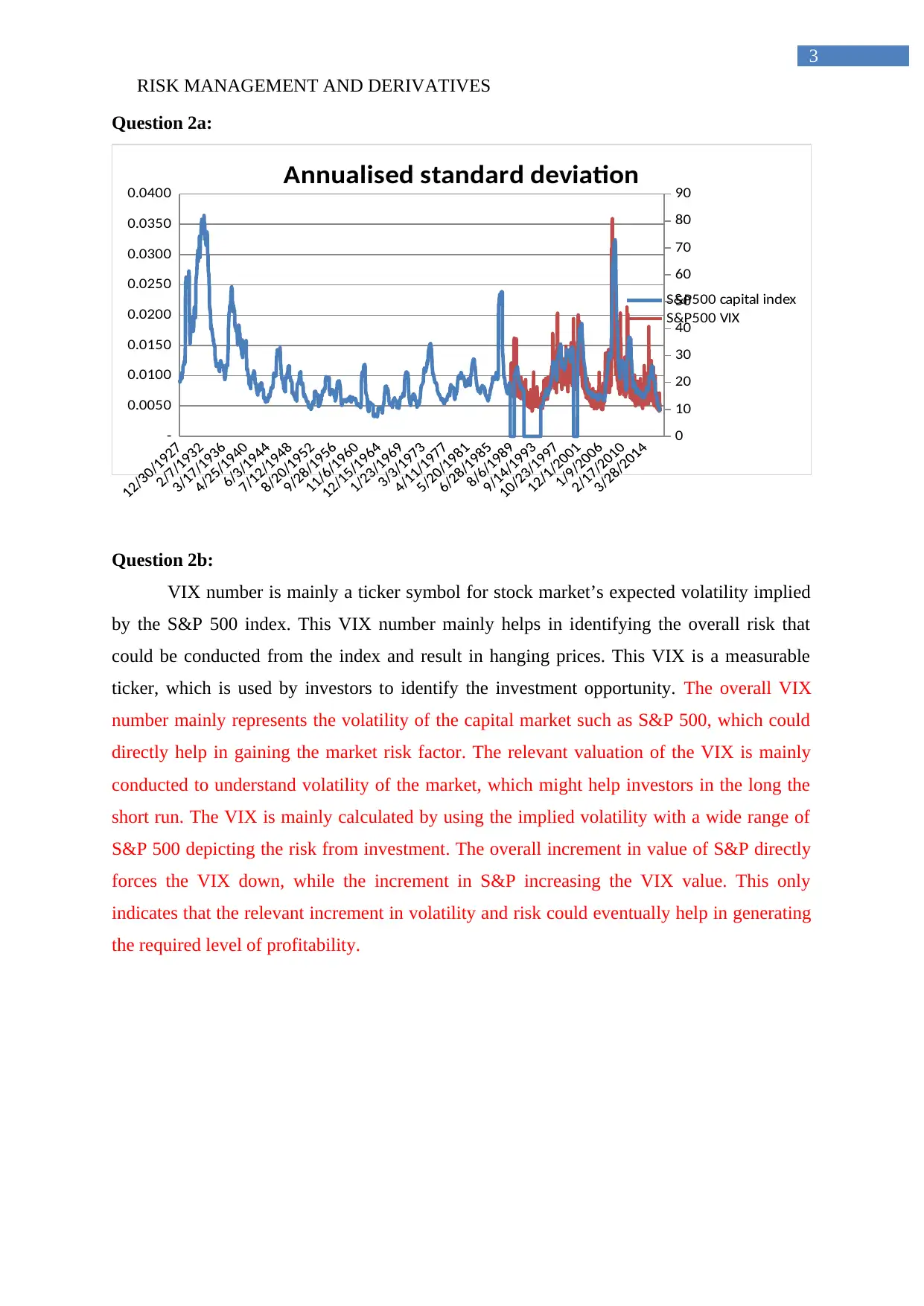
3
RISK MANAGEMENT AND DERIVATIVES
Question 2a:
-
0.0050
0.0100
0.0150
0.0200
0.0250
0.0300
0.0350
0.0400
0
10
20
30
40
50
60
70
80
90
Annualised standard deviation
S&P500 capital index
S&P500 VIX
Question 2b:
VIX number is mainly a ticker symbol for stock market’s expected volatility implied
by the S&P 500 index. This VIX number mainly helps in identifying the overall risk that
could be conducted from the index and result in hanging prices. This VIX is a measurable
ticker, which is used by investors to identify the investment opportunity. The overall VIX
number mainly represents the volatility of the capital market such as S&P 500, which could
directly help in gaining the market risk factor. The relevant valuation of the VIX is mainly
conducted to understand volatility of the market, which might help investors in the long the
short run. The VIX is mainly calculated by using the implied volatility with a wide range of
S&P 500 depicting the risk from investment. The overall increment in value of S&P directly
forces the VIX down, while the increment in S&P increasing the VIX value. This only
indicates that the relevant increment in volatility and risk could eventually help in generating
the required level of profitability.
RISK MANAGEMENT AND DERIVATIVES
Question 2a:
-
0.0050
0.0100
0.0150
0.0200
0.0250
0.0300
0.0350
0.0400
0
10
20
30
40
50
60
70
80
90
Annualised standard deviation
S&P500 capital index
S&P500 VIX
Question 2b:
VIX number is mainly a ticker symbol for stock market’s expected volatility implied
by the S&P 500 index. This VIX number mainly helps in identifying the overall risk that
could be conducted from the index and result in hanging prices. This VIX is a measurable
ticker, which is used by investors to identify the investment opportunity. The overall VIX
number mainly represents the volatility of the capital market such as S&P 500, which could
directly help in gaining the market risk factor. The relevant valuation of the VIX is mainly
conducted to understand volatility of the market, which might help investors in the long the
short run. The VIX is mainly calculated by using the implied volatility with a wide range of
S&P 500 depicting the risk from investment. The overall increment in value of S&P directly
forces the VIX down, while the increment in S&P increasing the VIX value. This only
indicates that the relevant increment in volatility and risk could eventually help in generating
the required level of profitability.
Paraphrase This Document
Need a fresh take? Get an instant paraphrase of this document with our AI Paraphraser
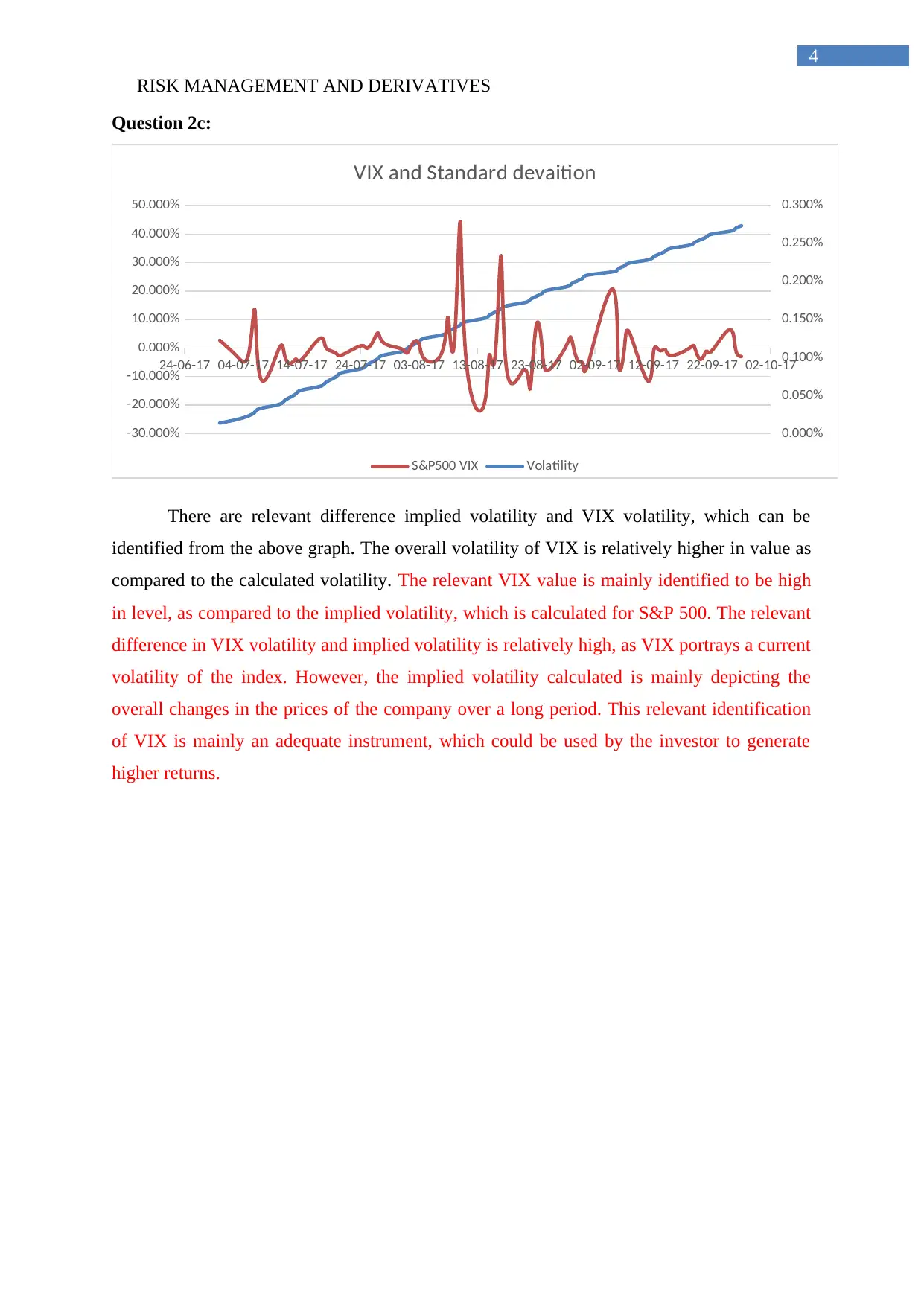
4
RISK MANAGEMENT AND DERIVATIVES
Question 2c:
24-06-17 04-07-17 14-07-17 24-07-17 03-08-17 13-08-17 23-08-17 02-09-17 12-09-17 22-09-17 02-10-17
-30.000%
-20.000%
-10.000%
0.000%
10.000%
20.000%
30.000%
40.000%
50.000%
0.000%
0.050%
0.100%
0.150%
0.200%
0.250%
0.300%
VIX and Standard devaition
S&P500 VIX Volatility
There are relevant difference implied volatility and VIX volatility, which can be
identified from the above graph. The overall volatility of VIX is relatively higher in value as
compared to the calculated volatility. The relevant VIX value is mainly identified to be high
in level, as compared to the implied volatility, which is calculated for S&P 500. The relevant
difference in VIX volatility and implied volatility is relatively high, as VIX portrays a current
volatility of the index. However, the implied volatility calculated is mainly depicting the
overall changes in the prices of the company over a long period. This relevant identification
of VIX is mainly an adequate instrument, which could be used by the investor to generate
higher returns.
RISK MANAGEMENT AND DERIVATIVES
Question 2c:
24-06-17 04-07-17 14-07-17 24-07-17 03-08-17 13-08-17 23-08-17 02-09-17 12-09-17 22-09-17 02-10-17
-30.000%
-20.000%
-10.000%
0.000%
10.000%
20.000%
30.000%
40.000%
50.000%
0.000%
0.050%
0.100%
0.150%
0.200%
0.250%
0.300%
VIX and Standard devaition
S&P500 VIX Volatility
There are relevant difference implied volatility and VIX volatility, which can be
identified from the above graph. The overall volatility of VIX is relatively higher in value as
compared to the calculated volatility. The relevant VIX value is mainly identified to be high
in level, as compared to the implied volatility, which is calculated for S&P 500. The relevant
difference in VIX volatility and implied volatility is relatively high, as VIX portrays a current
volatility of the index. However, the implied volatility calculated is mainly depicting the
overall changes in the prices of the company over a long period. This relevant identification
of VIX is mainly an adequate instrument, which could be used by the investor to generate
higher returns.
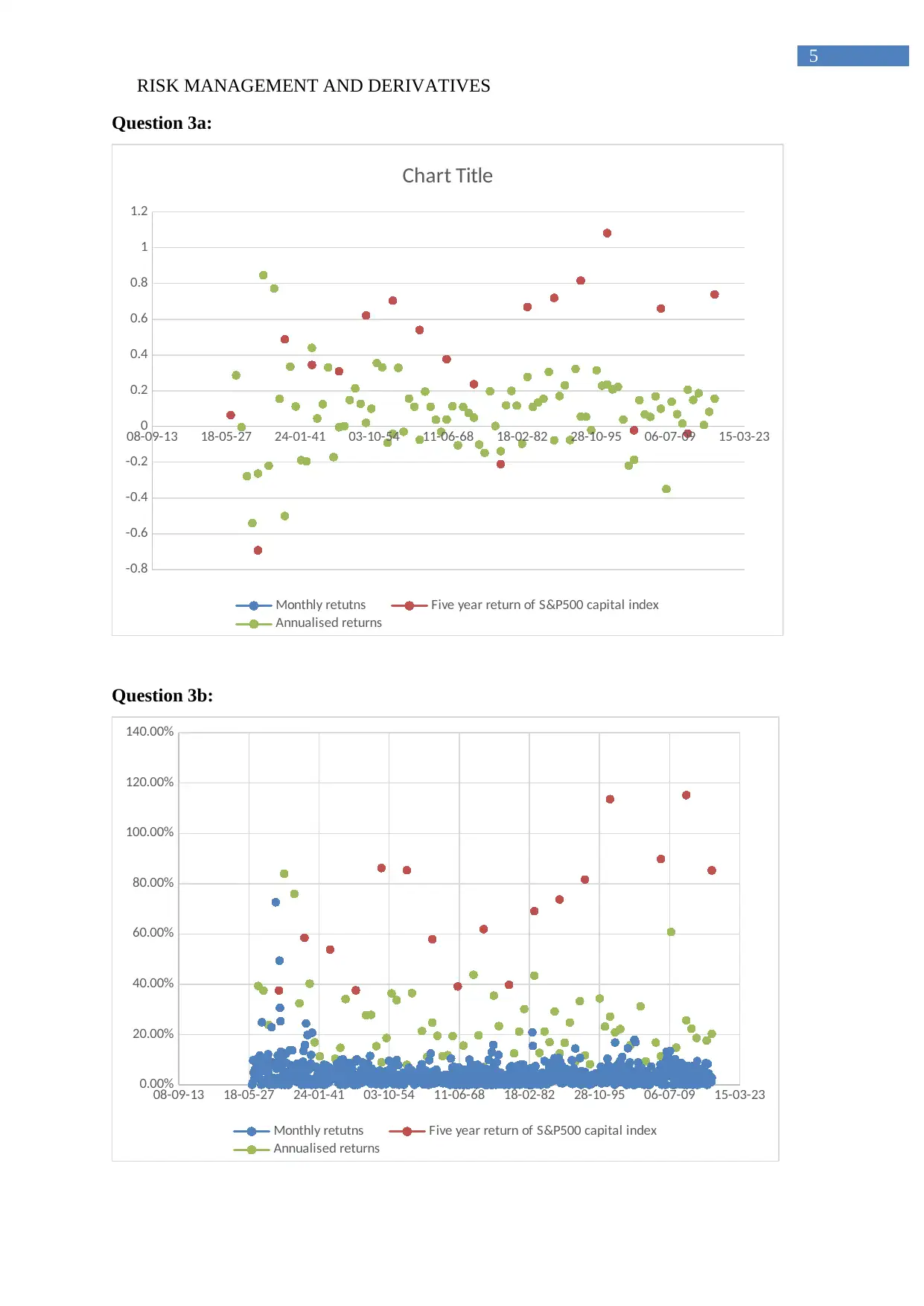
5
RISK MANAGEMENT AND DERIVATIVES
Question 3a:
08-09-13 18-05-27 24-01-41 03-10-54 11-06-68 18-02-82 28-10-95 06-07-09 15-03-23
-0.8
-0.6
-0.4
-0.2
0
0.2
0.4
0.6
0.8
1
1.2
Chart Title
Monthly retutns Five year return of S&P500 capital index
Annualised returns
Question 3b:
08-09-13 18-05-27 24-01-41 03-10-54 11-06-68 18-02-82 28-10-95 06-07-09 15-03-23
0.00%
20.00%
40.00%
60.00%
80.00%
100.00%
120.00%
140.00%
Monthly retutns Five year return of S&P500 capital index
Annualised returns
RISK MANAGEMENT AND DERIVATIVES
Question 3a:
08-09-13 18-05-27 24-01-41 03-10-54 11-06-68 18-02-82 28-10-95 06-07-09 15-03-23
-0.8
-0.6
-0.4
-0.2
0
0.2
0.4
0.6
0.8
1
1.2
Chart Title
Monthly retutns Five year return of S&P500 capital index
Annualised returns
Question 3b:
08-09-13 18-05-27 24-01-41 03-10-54 11-06-68 18-02-82 28-10-95 06-07-09 15-03-23
0.00%
20.00%
40.00%
60.00%
80.00%
100.00%
120.00%
140.00%
Monthly retutns Five year return of S&P500 capital index
Annualised returns
⊘ This is a preview!⊘
Do you want full access?
Subscribe today to unlock all pages.

Trusted by 1+ million students worldwide
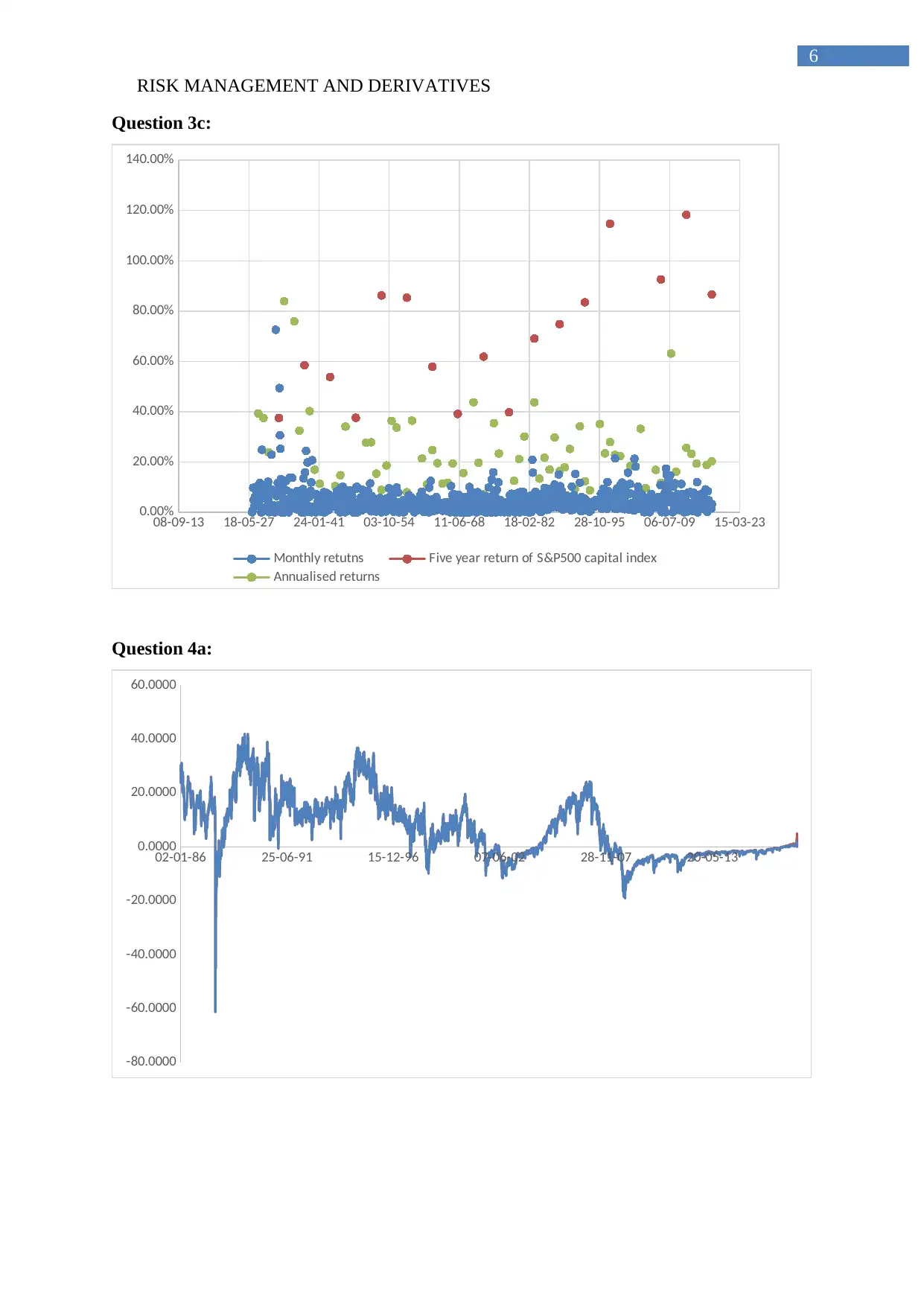
6
RISK MANAGEMENT AND DERIVATIVES
Question 3c:
08-09-13 18-05-27 24-01-41 03-10-54 11-06-68 18-02-82 28-10-95 06-07-09 15-03-23
0.00%
20.00%
40.00%
60.00%
80.00%
100.00%
120.00%
140.00%
Monthly retutns Five year return of S&P500 capital index
Annualised returns
Question 4a:
02-01-86 25-06-91 15-12-96 07-06-02 28-11-07 20-05-13
-80.0000
-60.0000
-40.0000
-20.0000
0.0000
20.0000
40.0000
60.0000
RISK MANAGEMENT AND DERIVATIVES
Question 3c:
08-09-13 18-05-27 24-01-41 03-10-54 11-06-68 18-02-82 28-10-95 06-07-09 15-03-23
0.00%
20.00%
40.00%
60.00%
80.00%
100.00%
120.00%
140.00%
Monthly retutns Five year return of S&P500 capital index
Annualised returns
Question 4a:
02-01-86 25-06-91 15-12-96 07-06-02 28-11-07 20-05-13
-80.0000
-60.0000
-40.0000
-20.0000
0.0000
20.0000
40.0000
60.0000
Paraphrase This Document
Need a fresh take? Get an instant paraphrase of this document with our AI Paraphraser

7
RISK MANAGEMENT AND DERIVATIVES
Question 4b:
The above calculation will under-state the real-work risk averse probability of a
margin call, as the tenure for the calculation is relatively taken to be at the level of 90 years
(Guo, 2017). The data taken for the overall calculation is relatively old and is not able to
grasp the actual risk averse, which is situated in the real world.
Question 4c:
The first adjustment for getting realistic N(d2) is to change the time years in which
the calculations is conducted. The risk neutrality BS equation directly evaluates all the
relevant criteria’s for identifying the risk adverse probability.
Question 5a:
30-12-27 07-09-41 17-05-55 23-01-69 02-10-82 10-06-96 17-02-10
$-
$50.0000
$100.0000
$150.0000
$200.0000
$250.0000
$300.0000
$350.0000
$400.0000
$450.0000
$500.0000
Portraying returns
Customer equity 1 Customer equity 2 Customer equity 3
RISK MANAGEMENT AND DERIVATIVES
Question 4b:
The above calculation will under-state the real-work risk averse probability of a
margin call, as the tenure for the calculation is relatively taken to be at the level of 90 years
(Guo, 2017). The data taken for the overall calculation is relatively old and is not able to
grasp the actual risk averse, which is situated in the real world.
Question 4c:
The first adjustment for getting realistic N(d2) is to change the time years in which
the calculations is conducted. The risk neutrality BS equation directly evaluates all the
relevant criteria’s for identifying the risk adverse probability.
Question 5a:
30-12-27 07-09-41 17-05-55 23-01-69 02-10-82 10-06-96 17-02-10
$-
$50.0000
$100.0000
$150.0000
$200.0000
$250.0000
$300.0000
$350.0000
$400.0000
$450.0000
$500.0000
Portraying returns
Customer equity 1 Customer equity 2 Customer equity 3
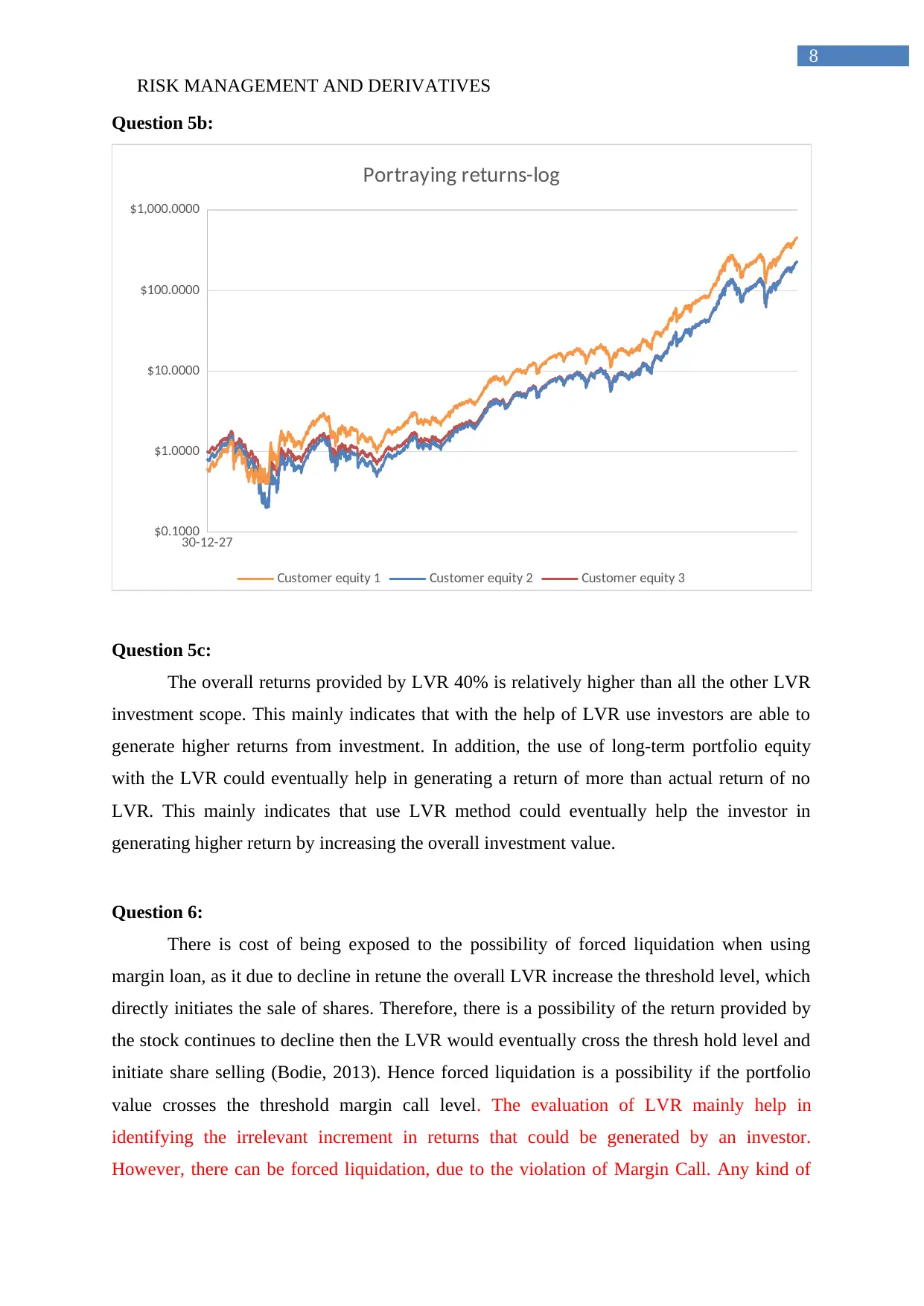
8
RISK MANAGEMENT AND DERIVATIVES
Question 5b:
30-12-27
$0.1000
$1.0000
$10.0000
$100.0000
$1,000.0000
Portraying returns-log
Customer equity 1 Customer equity 2 Customer equity 3
Question 5c:
The overall returns provided by LVR 40% is relatively higher than all the other LVR
investment scope. This mainly indicates that with the help of LVR use investors are able to
generate higher returns from investment. In addition, the use of long-term portfolio equity
with the LVR could eventually help in generating a return of more than actual return of no
LVR. This mainly indicates that use LVR method could eventually help the investor in
generating higher return by increasing the overall investment value.
Question 6:
There is cost of being exposed to the possibility of forced liquidation when using
margin loan, as it due to decline in retune the overall LVR increase the threshold level, which
directly initiates the sale of shares. Therefore, there is a possibility of the return provided by
the stock continues to decline then the LVR would eventually cross the thresh hold level and
initiate share selling (Bodie, 2013). Hence forced liquidation is a possibility if the portfolio
value crosses the threshold margin call level. The evaluation of LVR mainly help in
identifying the irrelevant increment in returns that could be generated by an investor.
However, there can be forced liquidation, due to the violation of Margin Call. Any kind of
RISK MANAGEMENT AND DERIVATIVES
Question 5b:
30-12-27
$0.1000
$1.0000
$10.0000
$100.0000
$1,000.0000
Portraying returns-log
Customer equity 1 Customer equity 2 Customer equity 3
Question 5c:
The overall returns provided by LVR 40% is relatively higher than all the other LVR
investment scope. This mainly indicates that with the help of LVR use investors are able to
generate higher returns from investment. In addition, the use of long-term portfolio equity
with the LVR could eventually help in generating a return of more than actual return of no
LVR. This mainly indicates that use LVR method could eventually help the investor in
generating higher return by increasing the overall investment value.
Question 6:
There is cost of being exposed to the possibility of forced liquidation when using
margin loan, as it due to decline in retune the overall LVR increase the threshold level, which
directly initiates the sale of shares. Therefore, there is a possibility of the return provided by
the stock continues to decline then the LVR would eventually cross the thresh hold level and
initiate share selling (Bodie, 2013). Hence forced liquidation is a possibility if the portfolio
value crosses the threshold margin call level. The evaluation of LVR mainly help in
identifying the irrelevant increment in returns that could be generated by an investor.
However, there can be forced liquidation, due to the violation of Margin Call. Any kind of
⊘ This is a preview!⊘
Do you want full access?
Subscribe today to unlock all pages.

Trusted by 1+ million students worldwide
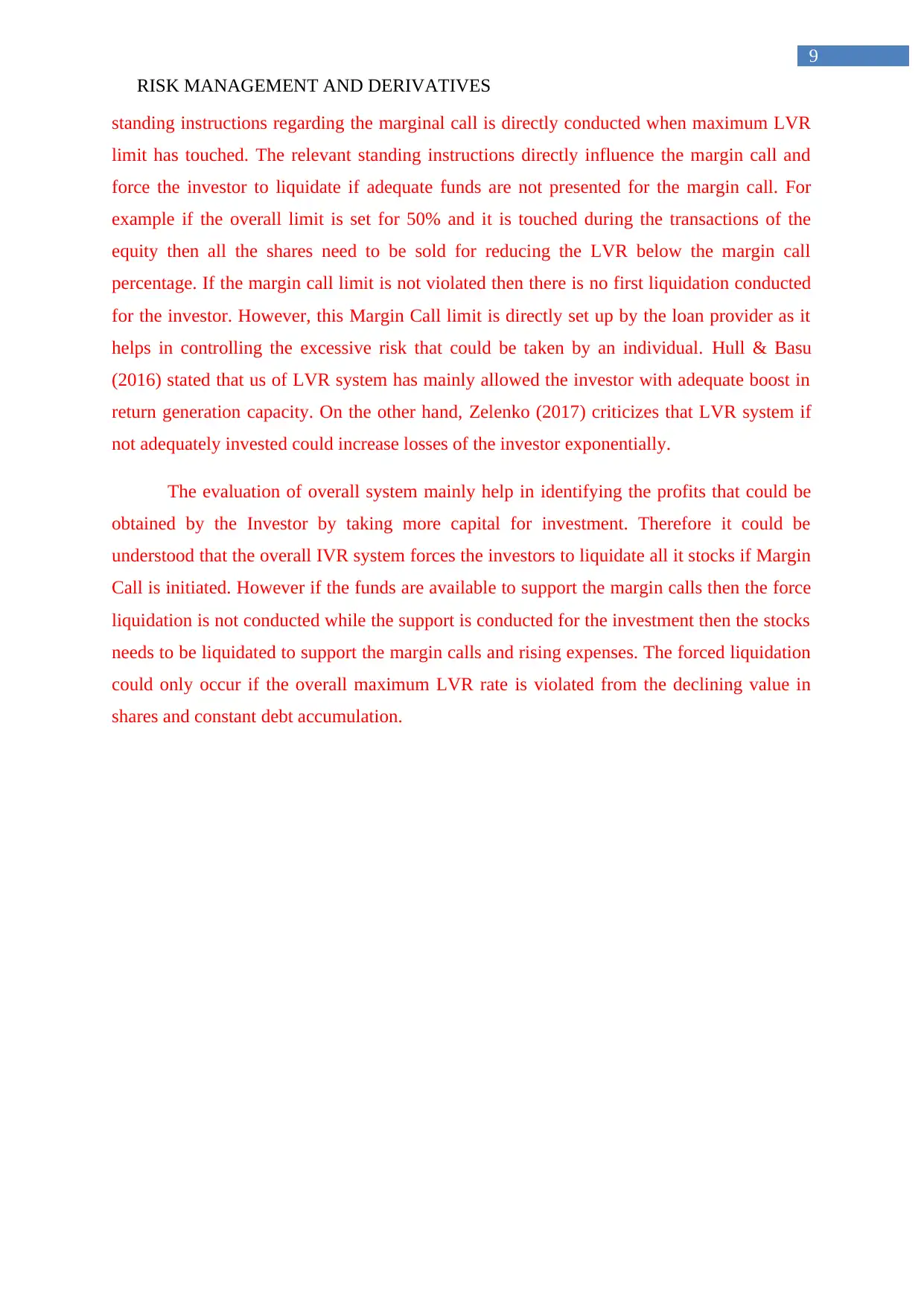
9
RISK MANAGEMENT AND DERIVATIVES
standing instructions regarding the marginal call is directly conducted when maximum LVR
limit has touched. The relevant standing instructions directly influence the margin call and
force the investor to liquidate if adequate funds are not presented for the margin call. For
example if the overall limit is set for 50% and it is touched during the transactions of the
equity then all the shares need to be sold for reducing the LVR below the margin call
percentage. If the margin call limit is not violated then there is no first liquidation conducted
for the investor. However, this Margin Call limit is directly set up by the loan provider as it
helps in controlling the excessive risk that could be taken by an individual. Hull & Basu
(2016) stated that us of LVR system has mainly allowed the investor with adequate boost in
return generation capacity. On the other hand, Zelenko (2017) criticizes that LVR system if
not adequately invested could increase losses of the investor exponentially.
The evaluation of overall system mainly help in identifying the profits that could be
obtained by the Investor by taking more capital for investment. Therefore it could be
understood that the overall IVR system forces the investors to liquidate all it stocks if Margin
Call is initiated. However if the funds are available to support the margin calls then the force
liquidation is not conducted while the support is conducted for the investment then the stocks
needs to be liquidated to support the margin calls and rising expenses. The forced liquidation
could only occur if the overall maximum LVR rate is violated from the declining value in
shares and constant debt accumulation.
RISK MANAGEMENT AND DERIVATIVES
standing instructions regarding the marginal call is directly conducted when maximum LVR
limit has touched. The relevant standing instructions directly influence the margin call and
force the investor to liquidate if adequate funds are not presented for the margin call. For
example if the overall limit is set for 50% and it is touched during the transactions of the
equity then all the shares need to be sold for reducing the LVR below the margin call
percentage. If the margin call limit is not violated then there is no first liquidation conducted
for the investor. However, this Margin Call limit is directly set up by the loan provider as it
helps in controlling the excessive risk that could be taken by an individual. Hull & Basu
(2016) stated that us of LVR system has mainly allowed the investor with adequate boost in
return generation capacity. On the other hand, Zelenko (2017) criticizes that LVR system if
not adequately invested could increase losses of the investor exponentially.
The evaluation of overall system mainly help in identifying the profits that could be
obtained by the Investor by taking more capital for investment. Therefore it could be
understood that the overall IVR system forces the investors to liquidate all it stocks if Margin
Call is initiated. However if the funds are available to support the margin calls then the force
liquidation is not conducted while the support is conducted for the investment then the stocks
needs to be liquidated to support the margin calls and rising expenses. The forced liquidation
could only occur if the overall maximum LVR rate is violated from the declining value in
shares and constant debt accumulation.
Paraphrase This Document
Need a fresh take? Get an instant paraphrase of this document with our AI Paraphraser
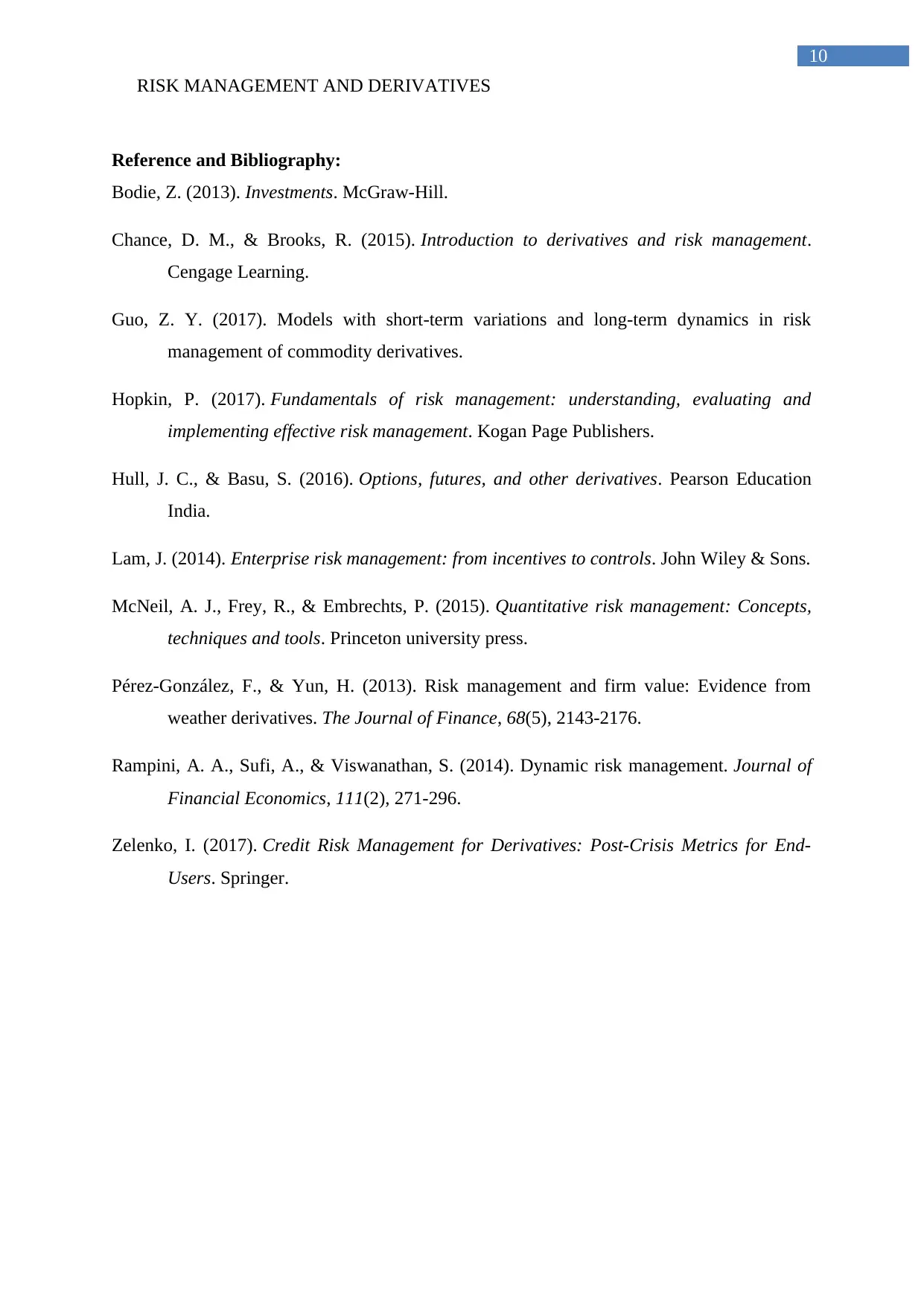
10
RISK MANAGEMENT AND DERIVATIVES
Reference and Bibliography:
Bodie, Z. (2013). Investments. McGraw-Hill.
Chance, D. M., & Brooks, R. (2015). Introduction to derivatives and risk management.
Cengage Learning.
Guo, Z. Y. (2017). Models with short-term variations and long-term dynamics in risk
management of commodity derivatives.
Hopkin, P. (2017). Fundamentals of risk management: understanding, evaluating and
implementing effective risk management. Kogan Page Publishers.
Hull, J. C., & Basu, S. (2016). Options, futures, and other derivatives. Pearson Education
India.
Lam, J. (2014). Enterprise risk management: from incentives to controls. John Wiley & Sons.
McNeil, A. J., Frey, R., & Embrechts, P. (2015). Quantitative risk management: Concepts,
techniques and tools. Princeton university press.
Pérez‐González, F., & Yun, H. (2013). Risk management and firm value: Evidence from
weather derivatives. The Journal of Finance, 68(5), 2143-2176.
Rampini, A. A., Sufi, A., & Viswanathan, S. (2014). Dynamic risk management. Journal of
Financial Economics, 111(2), 271-296.
Zelenko, I. (2017). Credit Risk Management for Derivatives: Post-Crisis Metrics for End-
Users. Springer.
RISK MANAGEMENT AND DERIVATIVES
Reference and Bibliography:
Bodie, Z. (2013). Investments. McGraw-Hill.
Chance, D. M., & Brooks, R. (2015). Introduction to derivatives and risk management.
Cengage Learning.
Guo, Z. Y. (2017). Models with short-term variations and long-term dynamics in risk
management of commodity derivatives.
Hopkin, P. (2017). Fundamentals of risk management: understanding, evaluating and
implementing effective risk management. Kogan Page Publishers.
Hull, J. C., & Basu, S. (2016). Options, futures, and other derivatives. Pearson Education
India.
Lam, J. (2014). Enterprise risk management: from incentives to controls. John Wiley & Sons.
McNeil, A. J., Frey, R., & Embrechts, P. (2015). Quantitative risk management: Concepts,
techniques and tools. Princeton university press.
Pérez‐González, F., & Yun, H. (2013). Risk management and firm value: Evidence from
weather derivatives. The Journal of Finance, 68(5), 2143-2176.
Rampini, A. A., Sufi, A., & Viswanathan, S. (2014). Dynamic risk management. Journal of
Financial Economics, 111(2), 271-296.
Zelenko, I. (2017). Credit Risk Management for Derivatives: Post-Crisis Metrics for End-
Users. Springer.
1 out of 11
Your All-in-One AI-Powered Toolkit for Academic Success.
+13062052269
info@desklib.com
Available 24*7 on WhatsApp / Email
![[object Object]](/_next/static/media/star-bottom.7253800d.svg)
Unlock your academic potential
Copyright © 2020–2025 A2Z Services. All Rights Reserved. Developed and managed by ZUCOL.


